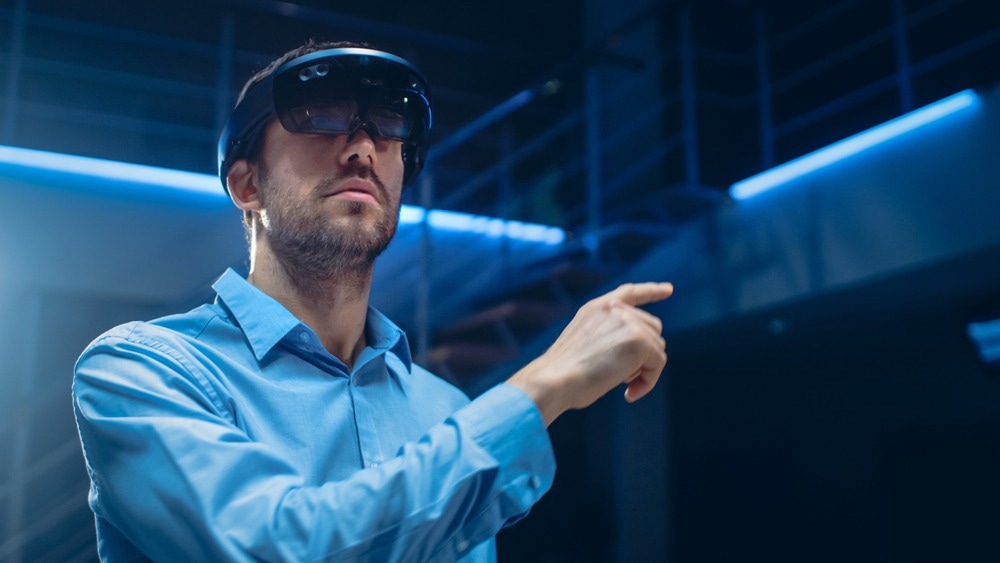Apple has launched the highly anticipated R1 chip, a customized microprocessor designed to drive its innovative mixed-reality headset, the Apple Vision Pro. With its exceptional capabilities and smooth integration with the M2 processor, the R1 chip is poised to redefine the immersive augmented reality (AR) experience.

Image Credit: Gorodenkoff/Shutterstock.com
Apple R1 Chip: A Look into The Future of Mixed Reality
Apple unveiled "Apple Vision Pro," its first mixed-reality headset, at WWDC 2023. This high-end headset, priced at $3,499 and set to be released in early 2024, distinguishes itself by combining augmented reality with a precise overlay of virtual components onto the user's environment.
Apple has incorporated a unique dual-chip design to achieve this level of performance.
The first chip, Apple's M2, handles standard operations such as opening apps, multitasking, and web browsing on the VisionOS. However, to deliver a seamless and responsive three-dimensional experience that synchronizes with users' movements, Apple introduced its custom-designed R1 chip.
The R1 chip complements the M2 processor in mixed-reality headsets by handling sensor data processing, resulting in a fast and lag-free experience.
Its main purpose is to process data collected by the headset's array of sensors, allowing for precise head and hand tracking, real-time 3D mapping, and eye-tracking functionality.
How Does the Apple R1 Chip Improve the New Vision Pro AR Headset's Functionality and Features?
The Apple R1 chip takes the input from 12 cameras, five sensors, and six microphones, including the TrueDepth camera system and LiDAR sensor.
Motion sickness is often triggered in AR headsets due to noticeable delays between physical movement and the corresponding visual feedback from these sensors. Apple's primary objective with the R1 chip was to address these challenges to ensure smoother and more enjoyable mixed-reality interactions.
The R1 chip achieves this by processing input data within an incredibly fast timeframe of 12 milliseconds, eight times faster than the blink of an eye. This rapid processing reduces the risk of motion sickness and discomfort associated with delays in virtual and augmented reality experiences, resulting in a more responsive, enjoyable, and immersive AR experience.
The R1 chip's low latency and high-speed sensor processing capabilities empower users to control Immersive Environments, engage in spatial FaceTime, and enjoy enhanced app experiences, elevating the functionality and overall user experience of the Vision Pro headset.
How has Apple's Expertise in Integrated Circuit and Its Superior Silicon Technology Influenced the Development of The R1 Chip?
The introduction of the Apple R1 chip in the Vision Pro AR headset represents a significant leap forward in mixed reality experiences.
Leveraging Apple's extensive experience designing custom chips for their mobile devices, the R1 chip benefits from its expertise in prioritizing performance and power efficiency.
Deep integration between hardware and software, including specialized technologies like the Secure Enclave and high-performance graphics capabilities, sets Apple's custom chips apart from the competition.
These chips also incorporate features such as Machine Learning Accelerators and Neural Engines, making them ideal platforms for machine learning tasks. With a focus on performance, power efficiency, and seamless software-hardware integration, Apple's custom chips bring notable advantages to their devices.
By focusing on performance, power efficiency, and seamless software-hardware integration, Apple's expertise in integrated circuits and superior silicon technology has played a pivotal role in shaping the development of the R1 chip, driving the Vision Pro AR headset to deliver an immersive and responsive mixed-reality environment.
Potential Downsides of The R1 Chip
While incorporating the R1 chip in Apple's Vision Pro headset provides several advantages, it raises some concerns.
Battery Life Considerations
The simultaneous operation of two processors, the R1 and M2 chips, limits the headset's battery life to approximately two hours on a single charge. This may come as a surprise to MacBook Air users who are accustomed to the M2 chip's energy efficiency.
However, the demanding processing requirements of the R1 chip unavoidably increase power consumption.
The High Price of High Technology
The dual-chip design adds to the overall cost of the Vision Pro headset, priced at $3499, making it a substantial investment. However, the higher price reflects the advanced technology and immersive experience that Apple aims to deliver to users.
Concluding Remarks
While the chip contributes to the higher price and power consumption, its fast processing capabilities effectively address motion sickness challenges and provide a seamless and immersive mixed-reality experience.
The R1 chip, working alongside the M2 chip, showcases Apple's commitment to pushing the boundaries of technology and delivering unparalleled sensory immersion and interactivity to users.
More from AZoM: Machine Learning and Semiconductor Manufacturing
References and Further Reading
Haje Jan Kamps. (2023). To reduce motion sickness in VR, Apple developed the new R1 chip. [Online]. Tech Crunch. Available from: https://techcrunch.com/2023/06/05/apple-r1-chip-apple-vision-pro/ (Accessed on 07 June 2023)
Itani, M. (2023). Apple Silicon: Everything you need to know about Apple's own chips. [Online]. XDA Developers. Available from: https://www.xda-developers.com/apple-silicon/ (Accessed on 07 June 2023)
Jones, R. (2023). What is the Apple R1 processor? The new chip explained. [Online]. Trusted Reviews. Available from: https://www.trustedreviews.com/explainer/what-is-the-apple-r1-processor-4333904 (Accessed on 07 June 2023)
Roy, J & Schubert, A. (2023). Introducing Apple Vision Pro: Apple's first spatial computer. [Online]. Apple's Newsroom. Available from: https://www.apple.com/newsroom/2023/06/introducing-apple-vision-pro/ (Accessed on 07 June 2023)
Disclaimer: The views expressed here are those of the author expressed in their private capacity and do not necessarily represent the views of AZoM.com Limited T/A AZoNetwork the owner and operator of this website. This disclaimer forms part of the Terms and conditions of use of this website.